

 20
20









 2
2





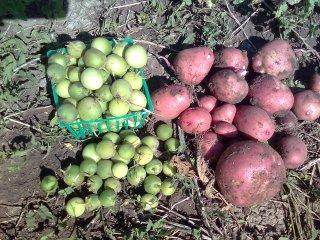
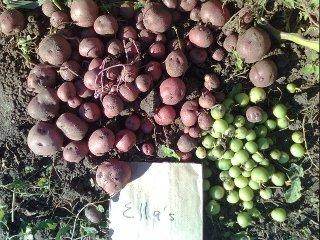




Joseph Lofthouse wrote:
The potatoes that I grow produce both seeds and tubers in the first growing season. Potato seeds are very small, so they are slow to get going in the spring. Tubers are huge and start up fast. With my very short growing season that means that harvest is typically larger for tuber planted clones than for seedlings. I say typically, because sometimes seedlings produce many more tubers for me than different clones planted from tubers. Some plants grown from tubers don't produce a harvest for me and die out.
Here's what the yield looked like for some potatoes grown from seeds. Each basket it the production from one plant.
Here's what the harvest looked like from single tubers in the second year: Tuber from the top row 3rd from left in the above photo.
Second row from top, All the way left.

 1
1




Nicole Alderman wrote:I just gotta say, those are some beautiful looking potatoes! The little green ones and the pink ones come from the same plant, right? Is there a reason for the difference in size and color? Do they taste different, too?
Thank you, also, for sharing your knowledge on potato growing. This is fascinating!
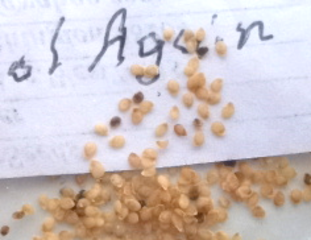
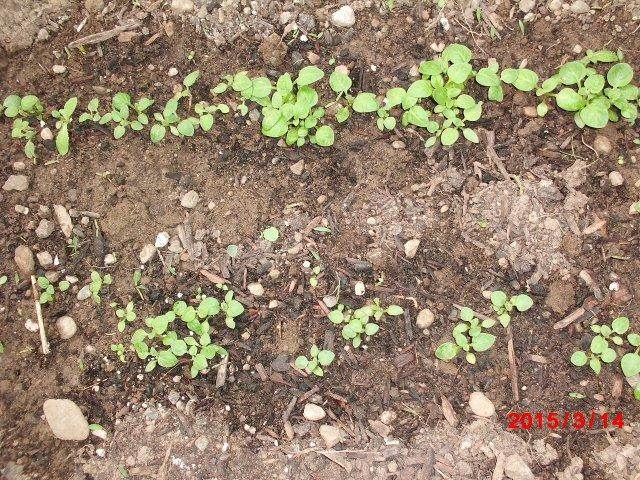
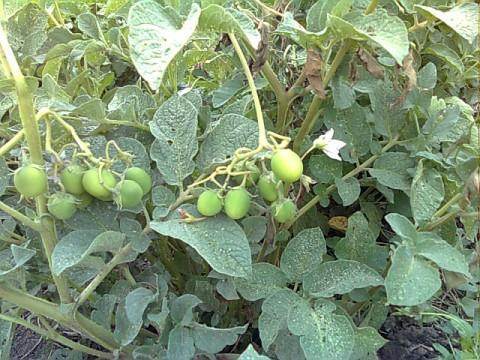
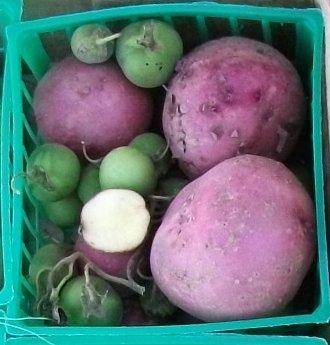
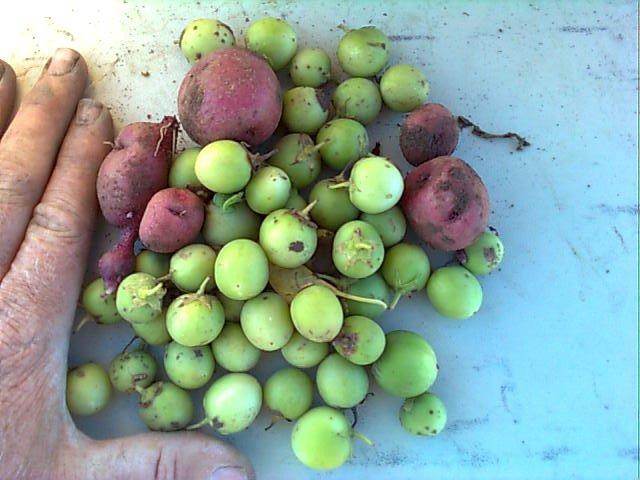
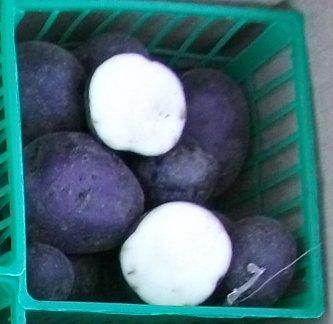
 1
1





 6
6








 1
1




Joseph Lofthouse wrote:
I grow potato seeds about like tomatoes. Potato seeds respond well to the wintersown method.




Joseph Lofthouse wrote:I pick potato berries when they fall off the plant naturally, or just before the beginning of the fall frosts. Then I allow them to ripen further until a few of them start to rot, or they get soft (a month or two). Then I combine one cup of berries with 6 cups of water in a blender, and blend for 30 seconds. The seeds sink, the pulp floats. I pour off the pulp and rinse the seeds a few times with water, then dry them on a plate.
I grow potato seeds about like tomatoes. Potato seeds respond well to the wintersown method.

 3
3




Peter Ingot wrote:Which varieties did you start with?

 5
5








Xisca - pics! Dry subtropical Mediterranean - My project
However loud I tell it, this is never a truth, only my experience...
 16
16




 3
3




 3
3




 5
5




In the south when the wind gets to 75 mph they give it a name and call it a hurricane. Here we call it a mite windy...




I love this approach. So easy. So logical!Joseph Lofthouse wrote:As a plant breeder, I am generally welcoming to diseases and pests in my garden. Because if I have a lot of pathogens/diseases/pests then it is easier to select for varieties that thrive in my garden in spite of the farmer, the soil, the viruses, the animals, the bugs, the microorganisms, the climate, etc...
I am not convinced that crop rotation in small gardens is worthwhile, because micro-organisms are readily moved around a garden by walking, or tools, or wind, or animals. And insects can move from place to place. Many of the diseases and pests we fuss over travel continental distances in a single growing season. Many insect species are killed by my cold winters, but most years, they re-arrive during summer monsoonal weather. Even on large farms crop rotation may not be all that effective. Farmer's used to think that if they rotated between corn and soybeans that they could eliminate corn root worms. Turns out that the species has learned to fly away from the corn, and leave propagules in soybean fields... So they will be ready to start eating corn as soon as the soybeans are out of the field and the corn is planted. These days, crop rotation is favoring the worms.
I grow potatoes from pollinated seeds. About 5 growing seasons ago I initiated a standard operating procedure of discarding all potato clones that do not make lots of seeds. I love how much improvement my potatoes underwent by such a simple choice.
I don't molest the skunks, coons, pheasants, turkeys, or deer that eat my corn crop. What that means in practice is that over the years, my corn has developed resistance to animal predation.
If a potato plant in my garden attracts Colorado Potato Beetles, then the plant gets culled. If a tomato plant attracts them, then the tomato gets culled. The beetles are allowed to eat as much wild solanum as they like. I don't pay too much attention to weeding the wild solanum. It's a death sentence for a beetle to get caught on a domesticated plant. Death to the beetle, and death to the plant. I can enforce that contract, because the beetles are year round residents in my garden. I influence the genetics and culture of the beetles and the genetics of the domesticated plants.
I don't use crop protection chemicals, because I want the full strengths and especially the weaknesses of my varieties to be manifest. That allows me to make more informed decisions about which plants to use as seed-crops.
For me, it's cull, Cull, CULL!




Julia Dakin wrote:I made a video when Joseph Lofthouse visited my potato patch
 yes it's worth checking out!
yes it's worth checking out! 4
4




Joseph Lofthouse wrote:I pick potato berries when they fall off the plant naturally, or just before the beginning of the fall frosts. Then I allow them to ripen further until a few of them start to rot, or they get soft (a month or two). Then I combine one cup of berries with 6 cups of water in a blender, and blend for 30 seconds. The seeds sink, the pulp floats. I pour off the pulp and rinse the seeds a few times with water, then dry them on a plate.
I grow potato seeds about like tomatoes. Potato seeds respond well to the wintersown method.
 3
3




Ra Kenworth wrote:
Joseph Lofthouse wrote:I pick potato berries when they fall off the plant naturally, or just before the beginning of the fall frosts. Then I allow them to ripen further until a few of them start to rot, or they get soft (a month or two). Then I combine one cup of berries with 6 cups of water in a blender, and blend for 30 seconds. The seeds sink, the pulp floats. I pour off the pulp and rinse the seeds a few times with water, then dry them on a plate.
I grow potato seeds about like tomatoes. Potato seeds respond well to the wintersown method.
I don't have a blender (or many electrical appliances) and would be happy to pick the seeds out by hand if this would work?
I actually got a small handful of fruits odd one of my volunteer potato plants (they come out of potato peelings and I only put the peelings in one downwind spot of the garden in case they carry disease)
Anyway I am still to have successful homegrown potatos. Although I pick local potatos with thick skins still with soil on them, or not at all, I am still afraid of passing disease to my garden.
The fruits I found had few seeds so I froze the fruits in the freezer with the intention of late winter planting (I have some dry soil put aside for this.)
Is it possible to hand pick the seeds, and do they need any treatment, or, if so is freezing as is an alternative?
 2
2




Anthony Powell wrote:
Maybe the easiest way, works with tomatoes, is to set the ripe potato berry in a pot of potting compost to decay over winter, then help the seeds to disperse across the surface before it gets warm enough for things to germinate.
Otherwise, dropping the fruit in water and letting it rot. Pull out the skin in time. Eventually you can break the fruit open, then find your seeds swimming in the bottom: gently decant the water, first most of it, then the final drain. This process cuts through the germination inhibitor on these seeds. They're ready for drying and packing.


|
What are you doing? You are supposed to be reading this tiny ad!
The new permaculture playing cards kickstarter is now live!
https://www.kickstarter.com/projects/paulwheaton/garden-cards
|






